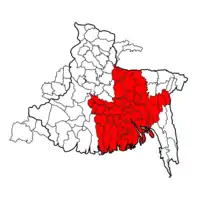Bangali (ethnic dialect)
Bangali is a dialect cluster of the Bengali language spoken in parts of Bangladesh and includes most of the varieties in the eastern subgroup of Bengali-Assamese languages spoken by Bengalis in the country. Sukumar Sen classified this dialect from other dialects.[1] Suniti Kumar Chatterji, describing the cluster as "Vanga Dialects", further divided it into two groups, "Western and S. W. Vanga" and "Eastern and S.E. Vanga". The Eastern and S.E. Vanga group includes the Sylheti and Chittagonian dialects (considered Independent languages by some) while the Western and S. W. Vanga group is spoken across the Divisions of Mymensingh, Dhaka, Comilla, Barisal and Khulna (excluding Satkhira district) in Bangladesh and the Indian state of Tripura.[2] The Bangali-speaking region covers most of the land of Bengal region.
| Bangali | |
|---|---|
| Bāṅgālī | |
| বাঙ্গালী | |
 | |
| Native to | Bangladesh |
| Region | Khulna, Dhaka, Mymensingh, Comilla Tripura |
| Bengali alphabet | |
| Language codes | |
| ISO 639-3 | – |
| Glottolog | east2744 Eastern Bengali |
Features
- Most of [e] sounds of Standard Bengali are [ɛ].
- [o] sounds are [ʊ].
- gulo, gula, gulain use as plural number instead of guli in some subdialects.
- Aspirations are lite or is not used.
- Standard Bengali /tʃ/ and /tʃʰ/ are /s/ and /tsʰ/ or /ts/.
- Most subdialects have tones.
- Standard Bengali /ʃ/ is /ɦ/ or absent especially in non-final positions in many subdialects.
- Standard Bengali /p/ and /pʰ/ are /ɸ/ in some subdialects and /ɦ/ in Nokhailla subdialect.
- Many subdialects have [m] and [n] which are nasal on vowels in Standard Bengali.
Examples:
1. (in IPA)
- English: The thieves are being beaten.
- Standard Bengali: /tʃorgulo maːr kʰatʃtʃʰe/
- A Bangali subdialect: /tsʊɾgulain piɖani kʰaitase/
2.
- English: A man had two sons.
- Standard Bengali: æk jon loker duţi chhele chhilo.
- Manikganji subdialect: zoner duiđi saoal asilo.}}
- Mymensinghiya subdialect: æk zôner dui put asilo.
- Munshiganji subdialect (Bikrampur): æk jôner duiđa pola asilo. (P)
- Comillan subdialect: æk bæđar/zôner dui put asilo. (P)
- Noakhali subdialect (Sandwip): egga mainsher duga hut/hula asilo.
- Nokhailla subdiaoect (Feni): egga mainsher duga hut/hula asilo. (P)
- Nokhailla subdialect (Hatia): egga mainsher duga hut/hula asilo. (P)
- Noakhailla subdialect (Ramganj): egga mainsher duga hut/hula asilo.
- Sylheti language: ex beţár dugú fuá/fút/sabal ásil/áslo.
- Chittagonian language: ugga mainshôr dugga fua asil.
- Chuadanga subdialect: æk jon lokir duiţo seile silo.
- Khulnaiya subdialect: æk zon manshir dui soal silo.
- Jessore subdialect: æk zoner duđe soal sêlo. (P)
- Borishailla subdialect (Bakerganj): æk zôn mansher/manur dugga pola asil.
- Foridpuri subdialect: kero mansher dugga pola silo.
- Satkhira subdialect: æk loker duđi sabal selo.
- Kushtia subdialect: æk mansher duđi seile silo.
See also
References
- বাংলা ভাষা ও উপভাষা, সুকুমার সেন, আনন্দ পাবলিশার্স
- Chatterji, Suniti Kumar (1926). The Origin and Development of the Bengali Language. Calcutta University Press. p. 140.